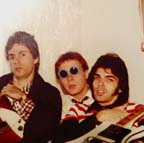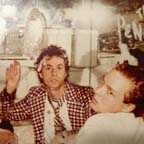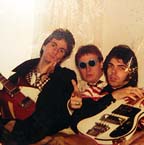1977-1984
(Ray Brandes delivers the definitive history of a band that shaped San Diego music. Excerpted from Ray’s book Getting Nowhere Fast. )
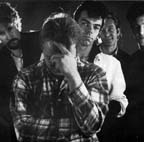 On October 8, 1977, Santana and Journey played to a sold-out crowd at the San Diego Sports Arena. That same night, across town at the Adams Avenue Theater, a decrepit former cinema, the Zeros, Dils and Hitmakers were making history by playing what has since come to be considered a milestone San Diego concert: the first big punk show.
On October 8, 1977, Santana and Journey played to a sold-out crowd at the San Diego Sports Arena. That same night, across town at the Adams Avenue Theater, a decrepit former cinema, the Zeros, Dils and Hitmakers were making history by playing what has since come to be considered a milestone San Diego concert: the first big punk show.
The audience was full of artists, musicians and poets, future movers and shakers who would go on to form bands, create fanzines, open independent record stores, and promote shows and galleries for decades to come. Among those in attendance were several young misfits who were drawn together by their love for early rock and roll and beat music and who would eventually change the local musical landscape as the Penetrators.
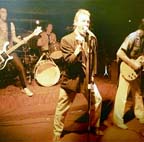 At the height of their popularity, the Penetrators were San Diego’s hometown heroes and media darlings, the local entry with the best chance to win the big-label sweepstakes. They took punk rock out of the downtown dives and brought it into suburban living rooms and car-radio speakers. In doing so they became bona fide local celebrities, selling out large arenas and hobnobbing with the Rolling Stones, Ramones and B-52s. It couldn’t have happened to a nicer or more deserving group of young men. They were kind and generous with their fans; supportive of local music; friendly, gregarious and fun. Most importantly, however, they were ever conscious of their roots and grateful for the opportunity to be the rising tide that would lift the boats of all of San Diego’s bands.
At the height of their popularity, the Penetrators were San Diego’s hometown heroes and media darlings, the local entry with the best chance to win the big-label sweepstakes. They took punk rock out of the downtown dives and brought it into suburban living rooms and car-radio speakers. In doing so they became bona fide local celebrities, selling out large arenas and hobnobbing with the Rolling Stones, Ramones and B-52s. It couldn’t have happened to a nicer or more deserving group of young men. They were kind and generous with their fans; supportive of local music; friendly, gregarious and fun. Most importantly, however, they were ever conscious of their roots and grateful for the opportunity to be the rising tide that would lift the boats of all of San Diego’s bands.
Queenie
The Penetrators can trace their roots to the late ‘60s, to a group of kids who used to gather at the home of popular Emerald Junior High School English teacher John Kmak, whose sons Joel and Jeff would listen to and play along with Beatles 45s. Among the musicians who found themselves at one time or another at the Kmaks’ Grand Central Station were Scott Harrington; Steve Kelly (later of the Hitmakers); and Dan McLain, whom Joel Kmak described seeing for the first time in his living room: “He was a tall, whippet-like kid who was just beating the crap out of the drums.”
 By the time they got to high school in the early ‘70s, drummer Joel Kmak; bassist Steve Kelly; Dan McLain (who had now switched to piano); and guitarists Brian Quinn and Brian Barto were already musically out of step with their peers. The band they formed, Queenie (named for the Chuck Berry song “Little Queenie”), was far more interested in Buddy Holly, Little Richard, the Kinks, the Who, the Animals and the Stones than the progressive hard rock favored by the unwashed masses at Grossmont High School. They were led by popular ASB Vice President McLain and soft-spoken musicologist Brian Barto, who was so obsessed with tracing the Beatles’ and Stones’ roots that “the joke was that Barto was going to get as far back as the Big Bang and disappear,” says Kmak.
By the time they got to high school in the early ‘70s, drummer Joel Kmak; bassist Steve Kelly; Dan McLain (who had now switched to piano); and guitarists Brian Quinn and Brian Barto were already musically out of step with their peers. The band they formed, Queenie (named for the Chuck Berry song “Little Queenie”), was far more interested in Buddy Holly, Little Richard, the Kinks, the Who, the Animals and the Stones than the progressive hard rock favored by the unwashed masses at Grossmont High School. They were led by popular ASB Vice President McLain and soft-spoken musicologist Brian Barto, who was so obsessed with tracing the Beatles’ and Stones’ roots that “the joke was that Barto was going to get as far back as the Big Bang and disappear,” says Kmak.
Queenie loaded Dan’s upright piano into his Ford Econoline van and traveled all over San Diego for gigs, even appearing several times at Jerry Herrera’s club JJ’s on Pacific Coast Highway. The band made sure to play obscure covers only, and often became antagonistic with the crowds who would clamor for the popular hits of the day. After playing “Bad Boy” or “Dizzy Miss Lizzy,” someone might call out for a Beatles song, Joel remembers. “Brian would shout out, ‘We just played a Beatles song, you bitch!’ We had an aggressive attitude,” says Kmak, “and when punk came along, we could totally relate to it. “
The Big Guy
Eventually, Queenie’s plans to move to LA to record and make it big were dashed when Barto and McLain had a bad falling-out and McLain quit the band. McLain married soon thereafter; became president of the San Diego Kinks Fan Club; and began to collect the records he would eventually use to open his own store, Monty Rockers.
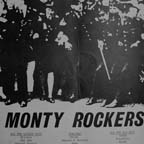 It was at Monty Rockers, out on El Cajon Boulevard, west of College Avenue, that McLain took on the role of den mother to a motley little collection of brilliant, funny, creative people. He was at home in his natural habitat, conducting impromptu rock-and-roll history lessons and sharing his favorite music with the clientele. McLain was the best kind of rock-and-roll mentor, encouraging kids to start bands; create their own fanzines; and of course, buy cool records. It’s hard to imagine a more important tastemaker in the early days of the San Diego scene.
It was at Monty Rockers, out on El Cajon Boulevard, west of College Avenue, that McLain took on the role of den mother to a motley little collection of brilliant, funny, creative people. He was at home in his natural habitat, conducting impromptu rock-and-roll history lessons and sharing his favorite music with the clientele. McLain was the best kind of rock-and-roll mentor, encouraging kids to start bands; create their own fanzines; and of course, buy cool records. It’s hard to imagine a more important tastemaker in the early days of the San Diego scene.
Meanwhile, over at Monte Vista High School in Spring Valley, former drummer Scott Harrington was deciding to learn the guitar. “During my senior year I decided I wanted to play guitar like Jimi Hendrix,” says Harrington. “I soon realized that’s a bad place for a guitarist to start. I started listening to Keith Richards, and through the Stones and Beatles, Chuck Berry.” After high school, Harrington and Kmak became reacquainted at Grossmont College and played together for a year or so at Harrington’s aunt’s house, sometimes joined by former Queenie bassist Steve Kelly. “At the time (1975-1976), there were no places to play unless you were a disco or Top 40 band,” recalls Kmak. “We’d put all our shit in our cars, go to biker bars and ask if they needed a band. A lot of the bikers wouldn’t be too happy because they’d have to stop playing pool!” Harrington adds, “At the time we were into British Invasion stuff, but speeding it up, making it faster and harder. I was scouring magazines like Creem and Trouser Press for new bands to listen to. It was all about not being Styx and Fleetwood Mac.”
Then, according to Kmak, “Punk hit, and within six months it seemed like the whole world had changed. There were all these kids hanging out at Monty Rockers. Every day you’d see somebody new, and you’d think, ‘Now there’s someone else on the team!’ “ Harrington recalls: “I said to Joel, ‘There is some new stuff going on, and we really need to get with it.’ We didn’t want to get left behind in the ‘70s, so we put an ad in the paper for people who were into Beatles, Kinks, Stones.”
At the time the Hitmakers — Joseph Marc, Jeff Scott and Ron Silva — were running a nearly identical ad in the Reader citing the Beatles, Stones and Kinks as influences. Harrington answered the ad and spoke to Jeff Scott, who invited Harrington, Kelly and Kmak to a party in Oceanside. The Zeros were playing, along with an embryonic version of the Hitmakers (Silva, Marc, Jeff Scott, and Silva’s brother on drums). The Hitmakers were looking for some other members and ended up taking Steve Kelly for bass. That left a frustrated Kmak and Harrington looking for a new bass player. The solution to their problem, in the form of a tall skinny kid with a jet-black pompadour and juvenile delinquent sideburns, showed up for an audition at the Harrington practice space a few weeks later.
“Three chords and an attitude”
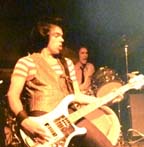 Chris Sullivan was born in Yonkers, N.Y., in a cross-section Italian and African-American neighborhood. He grew up in a household full of music — Johnny Cash and Duane Eddy were constantly on his older siblings’ turntable — and he started noodling with a guitar at age three. Sullivan remembers that “the lights came on for me in 1964 when the Beatles played the Ed Sullivan show.” He tried to put a band together that same week. “I went to Flagg Brothers for Beatle boots, but my parents wouldn’t let me get them,” he says. His father, who worked in elevator construction on the World Trade Center, pitched in 15 dollars to help him buy his very first electric guitar, a $40 metallic-blue Norma with four pickups. “I used to walk the streets, playing that guitar all day,” Sullivan remembers. “It was all three-chords-and-an-attitude music,” he says.
Chris Sullivan was born in Yonkers, N.Y., in a cross-section Italian and African-American neighborhood. He grew up in a household full of music — Johnny Cash and Duane Eddy were constantly on his older siblings’ turntable — and he started noodling with a guitar at age three. Sullivan remembers that “the lights came on for me in 1964 when the Beatles played the Ed Sullivan show.” He tried to put a band together that same week. “I went to Flagg Brothers for Beatle boots, but my parents wouldn’t let me get them,” he says. His father, who worked in elevator construction on the World Trade Center, pitched in 15 dollars to help him buy his very first electric guitar, a $40 metallic-blue Norma with four pickups. “I used to walk the streets, playing that guitar all day,” Sullivan remembers. “It was all three-chords-and-an-attitude music,” he says.
Sullivan’s other love was baseball — he would later be drafted by the Kansas City Royals at age 16 — but recalls a turning point occurring on his 14th birthday. “I had to choose between a Rawlings Brooks Robinson baseball glove and a wah-wah pedal,” he says. “I went with the wah-wah pedal.”
Due to his father’s poor health, the family packed up and moved to the warm climate of San Diego, where Sullivan finished his senior year at Mount Miguel High School in Spring Valley. In 1972, he was sporting an Elvis haircut and long sideburns and was listening exclusively to old blues, country and British Invasion music. “I didn’t get along with or hang out with too many people — they just didn’t know what to make of me,” Sullivan says. “But I wasn’t picked on because I had grown up in some pretty tough New York neighborhoods. I learned pretty early on to fight the leader of the group first.”
Sullivan graduated in 1973 and began attending Grossmont College, where he became acquainted with Sam Sanford, former guitarist and singer with ‘60s garage band the Gants. The two played a few military bases and frat parties in a group called Thunderbuck Ram. In early 1977 he answered the Reader ad placed by Harrington and Kmak and ended up at his first-ever music audition. “We played six or seven songs, and right away we clicked,” he recalls. “They took me aside and said, ‘We’d like to make you an offer to join our band.’ “
Just as Sullivan, Kmak and Harrington began to amass a catalog of songs, the Hitmakers again came calling. Kmak remembers: “After a couple of months, Joseph Marc decided he wanted to switch from drums to guitar. So one night, Steve Kelly came around to my house and said, ‘Guess what? These guys want you in the band. We got a gig in Hollywood. Are you in or out?’” Kmak was admittedly starstruck with the Hitmakers, who had some big shows lined up in Los Angeles. He joined without much thought. “The first gig I played with them was at the Masque with the Germs and the Bags,” he says. “Rodney Bingenheimer was sitting at the side of the stage.”
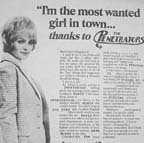 They had no drummer, and they had no singer, but Harrington and Sullivan had a band name, courtesy of Mark Williams, a high school friend of Chris’ who suggested “Rock Jetty and the Penetrators.” They once again resorted to their Reader ad. This time, however, they tried a new tactic. “We would go around to record stores like Blue Meanie and stick flyers in the bins next to cool records,” says Harrington. The flyers read: “Do You Want to Be a Penetrator?”
They had no drummer, and they had no singer, but Harrington and Sullivan had a band name, courtesy of Mark Williams, a high school friend of Chris’ who suggested “Rock Jetty and the Penetrators.” They once again resorted to their Reader ad. This time, however, they tried a new tactic. “We would go around to record stores like Blue Meanie and stick flyers in the bins next to cool records,” says Harrington. The flyers read: “Do You Want to Be a Penetrator?”
In the months that followed, word had began to circulate around town about a wild-eyed singer named Gary who fronted a band called Monotone and the Nucleoids. Harrington and Steve Kelly had seen him in line at the Ramones, taunting some jock types by dancing on the ground like a fried egg. Later, Sullivan would remember him as the fellow Elvis fan he met while camped out for tickets at the Sports Arena in 1972. Encountering Gary would be another critical moment for the band.
“We had heard about this party in La Mesa where a group called Monotone and the Nucleoids were playing,” says Sullivan. “We went there specifically to check out the singer.” According to Sullivan, Gary was “flapping around like Daffy Duck.” Harrington recalls: “The band wasn’t very good, but the singer had an energy and a personality, and we said, ‘Let’s talk to this guy and get his number.’ “ “Gary jumped on it right away,” says Sullivan. The three began rehearsing nearly every day.
To read the rest of the Penetrators’ story, purchase Getting Nowhere Fast, Ray Brandes’ definitive account of San Diego’s music underground from 1976 to 1986.
